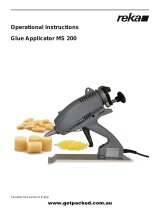CAB A+ series applicators are high-performance labeling machines designed for precise and efficient application of labels onto a wide range of products. With their advanced technology and versatile features, these applicators offer numerous benefits and potential use cases to enhance your labeling processes.
Here's a brief overview of the capabilities of your CAB A+ series applicator:
- Accurate and Reliable Labeling: The applicator utilizes advanced sensor technology to ensure accurate label placement and consistent application. The precise control of label positioning minimizes mislabeling and improves overall labeling quality.
CAB A+ series applicators are high-performance labeling machines designed for precise and efficient application of labels onto a wide range of products. With their advanced technology and versatile features, these applicators offer numerous benefits and potential use cases to enhance your labeling processes.
Here's a brief overview of the capabilities of your CAB A+ series applicator:
- Accurate and Reliable Labeling: The applicator utilizes advanced sensor technology to ensure accurate label placement and consistent application. The precise control of label positioning minimizes mislabeling and improves overall labeling quality.




















-
 1
1
-
 2
2
-
 3
3
-
 4
4
-
 5
5
-
 6
6
-
 7
7
-
 8
8
-
 9
9
-
 10
10
-
 11
11
-
 12
12
-
 13
13
-
 14
14
-
 15
15
-
 16
16
-
 17
17
-
 18
18
-
 19
19
-
 20
20
-
 21
21
-
 22
22
-
 23
23
-
 24
24
-
 25
25
CAB A+ series applicators are high-performance labeling machines designed for precise and efficient application of labels onto a wide range of products. With their advanced technology and versatile features, these applicators offer numerous benefits and potential use cases to enhance your labeling processes.
Here's a brief overview of the capabilities of your CAB A+ series applicator:
- Accurate and Reliable Labeling: The applicator utilizes advanced sensor technology to ensure accurate label placement and consistent application. The precise control of label positioning minimizes mislabeling and improves overall labeling quality.
Ask a question and I''ll find the answer in the document
Finding information in a document is now easier with AI
Related papers
-
CAB A+ series applicators User manual
-
CAB HERMES Q / Hermes+ applicators User manual
-
CAB Hermes+ User manual
-
CAB A+ series applicators User manual
-
CAB HERMES Q / Hermes+ applicators User manual
-
CAB Hermes applicators User manual
-
CAB HERMES Q User manual
-
CAB Hermes+ User manual
-
CAB HERMES Q / Hermes+ applicators User manual
-
CAB A+ series applicators Operating instructions
Other documents
-
Satco TP170 Operating instructions
-
Brady PAM 3600 User manual
-
Brady PAM 3000 User manual
-
ROOMS TO GO 90134239 Assembly Instructions
-
Carl Valentin Applicator APL 100 User manual
-
Compaq Compaq A1000 Supplementary Manual
-
GCC Technologies LaserPro C180II Quick start guide
-
 Reka MS 200 Operational Instructions
Reka MS 200 Operational Instructions
-
Carl Valentin Compa V + Pneumatic Applicator C User manual
-
Carl Valentin ILX + Applicator APX 7000 User manual

























